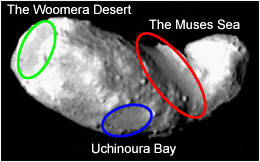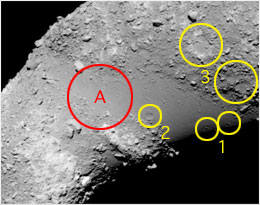 |
|||||
This is a relatively flat area. The name was chosen after JAXA's Uchinoura Space Center in Kagoshima, Japan, where JAXA has launched many scientific satellites, including Hayabusa. In fact, Uchinoura Town is now called Kimotsuki Town after a merger with its neighboring town, and therefore, administratively, the name of Uchinoura no longer exists. This is a smooth-surface area found at the heart of the asteroid. The name is after the code name for the Hayabusa project, MUSES-C. The Muses are from Greek Mythology, and are goddesses of the arts. Though its surface looks very smooth, a few rocks can still be seen on the Muses Sea. Some rock hems appear to have dents (see 1 in the image), for which the cause is a mystery. It will be very important to study the characteristics of the regolith of the Muses Sea. Also, a crater was found on the Muses Sea (see 2), and crater-like formations are observed in the bumpy area near the sea (see 3). The Muses Sea is Hayabusa's candidate landing point (see A), This is a large basin, and there is a high probability that the basin is actually a large-scale crater. With hope of success, the name was picked after the Woomera Desert in southern Australia where a sample capsule from Itokawa is scheduled to be retrieved in June 2007. It is rockier than the Muses Sea, but there are some smooth areas. Itokawa's biggest rock, which is 50m long, was found around the basin. |
|||||
|


